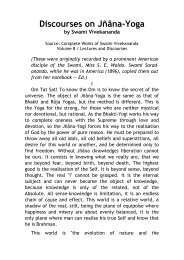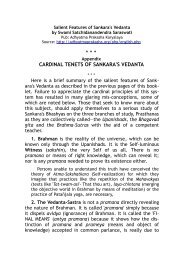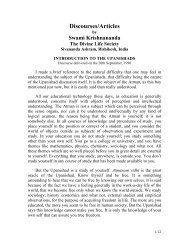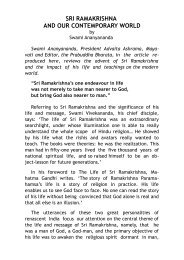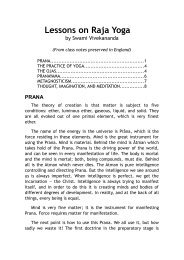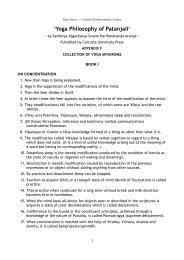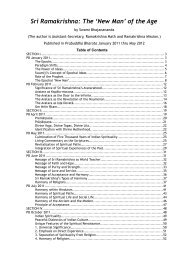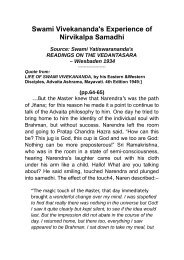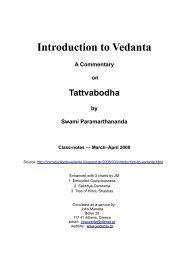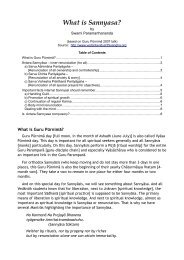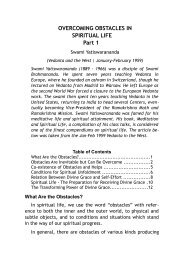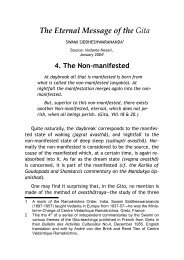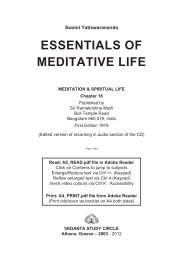Gita Summaries: Chapters 1-11 - Vedanta
Gita Summaries: Chapters 1-11 - Vedanta
Gita Summaries: Chapters 1-11 - Vedanta
You also want an ePaper? Increase the reach of your titles
YUMPU automatically turns print PDFs into web optimized ePapers that Google loves.
Swami Paramarthananda on <strong>Gita</strong> – <strong>Summaries</strong> of Chaps 1-<strong>11</strong><br />
If I lose sight of Para Prakriti and hold on to dying/changing Apara Prakriti then I lose my<br />
balance and become a samsari. Example, holding on to a crutch I fall; money, status,<br />
people are all changing things. The trick is to hold on to Para Prakriti and appreciate<br />
Apara Prakriti; then it becomes a sport. Love everyone; have transactions but for<br />
security depend on Para Prakriti.<br />
Is swimming enjoyable or frightening It depends on an individual and whether he knows<br />
swimming. Para Prakriti frees you while Apara Prakriti will freeze you.<br />
How to come to Para Prakriti<br />
Bhakti is the means; it means “love of God”. Which form of Lord<br />
It can be any form: Shiva or Vishnu or Rama or Krishna or Ganesha.<br />
Bhaktas have a lot of problems fighting amongst themselves. Some Vaishnavas will not<br />
go to a Shiva temple. This is wrong attitude. In truth, any form of God is appropriate<br />
as Ishwara is in all forms (nama and rupa), so any form represents God.<br />
Choose any form you like, for no form is superior or inferior to another. The mind cannot<br />
conceive totality and hence we take recourse to a form. Much like a country symbolized<br />
by a flag and anthem. You choose any form from a human being or trees or animals<br />
(cows), mother or father. There is only ONE Ishwara manifest through all the different<br />
symbols. In our religion it is not there are many gods but there are gods only<br />
everywhere.<br />
So accept any God. The god is not the 6 inches idol in front; it stands for the limitless<br />
Ishwara.<br />
Bhakti is in three stages and everyone must go through all the stages.<br />
A) Sakama Bhakti: Worship Ishwara to acquire worldly things. Ishwara becomes the<br />
means the worldly goals the end, either Sukha Praapti [seek pleasure] or Duhkha Nivritti<br />
[avoid pain]. Ishwara is the sadhana and worldly ends the sadhyam.<br />
Between sadhana and sadhyam which one do you love more Obviously the “ends” So<br />
this bhakti is a business deal,” Lord let me get a job and I shall do angapradakshanam”.<br />
Such a kind of bhakti should not be scoffed at; it is not nishida karma. It is perfectly<br />
allowed to pray to the Lord for worldly ends.<br />
Artha Bhakta is a sakama bhakta praying to get rid of something.<br />
Artatha Bhakta is a sakama bhakta who wishes to acquire something.<br />
B) Jijnasu: The mind becomes more and more matured as desire for material things<br />
comes down. I realize that by acquiring things I am not necessarily making my life any<br />
better. How one can insecure person holding on to another insecure person find security.<br />
Insecurity + insecurity == More insecurity.<br />
The world of objects is not really a worthy end; my end changes. Now I use the world to<br />
attain God. The world becomes the sadhana and Lord the sadhyam. I realize that family<br />
life is not an end in itself but an incidental thing we go through to attain the Lord.<br />
22



